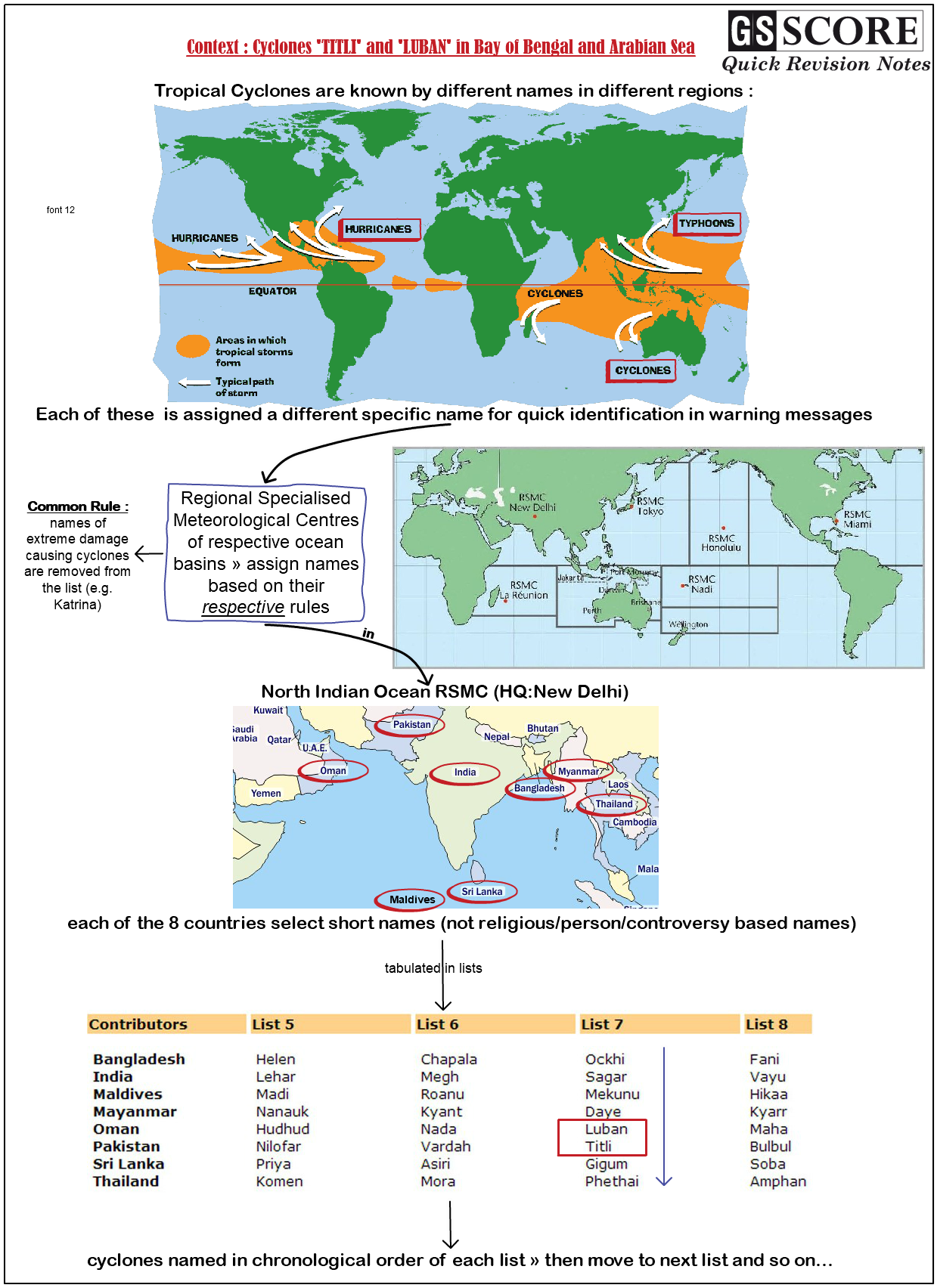

Cyclonic storm ‘TITLI’ has hit the Bay of Bengal and another cyclonic storm ‘LUBAN’ has hit the Arabian Sea.
Issue
Context
- Cyclonic storm ‘TITLI’ has hit the Bay of Bengal and another cyclonic storm ‘LUBAN’ has hit the Arabian Sea.
- The cyclonic season in India runs from April to December, with severe storms often causing dozens of deaths, evacuations of tens of thousands of people from low-lying villages and wide damage to crops and property.
Background
- Cyclones were usually not named. The tradition started with hurricanes in the Atlantic Ocean, where tropical storms that reach sustained wind speeds of 39 miles per hour were given names.
- The practice of naming storms started in order to help in the quick identification of storms in warning messages because names are presumed to be far easier to remember than numbers and technical terms.
- Experience shows that the use of short, distinctive given names in written as well as spoken communications is quicker and less subject to error than the older more cumbersome latitude-longitude identification methods.
Difference between Hurricanes, Cyclones and Typhoons
Hurricanes, cyclones and typhoons are all tropical storms. They are all the same thing but are given different names depending on where they appear. When they reach populated areas they usually bring very strong wind and rain which can cause a lot of damage.
Hurricanes are tropical storms that form over the North Atlantic Ocean and Northeast Pacific. Cyclones are formed over the South Pacific and Indian Ocean. Typhoons are formed over the Northwest Pacific Ocean.
Analysis
How cyclones are named?
- There is a strict procedure to determine a list of tropical cyclone names in an ocean basin(s) by the Tropical Cyclone Regional Body responsible for that basin(s) at its annual/biennial meeting.
- There are five tropical cyclone regional bodies, i.e. ESCAP/WMO Typhoon Committee, WMO/ESCAP Panel on Tropical Cyclones, RA I Tropical Cyclone Committee, RA IV Hurricane Committee, and RA V Tropical Cyclone Committee. For instance, Hurricane Committee determines a pre-designated list of hurricane names for six years separately at its annual session.
- The pre-designated list of hurricane names is proposed by its members that include National Meteorological and Hydrological Services in the North/Central America and the Caribbean.
- Naming procedures in other regions are almost the same as in the Caribbean. In general, tropical cyclones are named according to the rules at a regional level.
- The WMO/ESCAP Panel on Tropical Cyclones at its twenty-seventh Session held in 2000 in Muscat, Sultanate of Oman agreed in principal to assign names to the tropical cyclones in the Bay of Bengal and Arabian Sea. After long deliberations among the member countries, the naming of the tropical cyclones over north Indian Ocean commenced from September 2004.
- Eight countries — India, Pakistan, Bangladesh, Maldives, Myanmar, Oman, Sri Lanka and Thailand participated in the panel and came up with a list of 64 names.

- The Panel member names are listed alphabetically country wise.The names will be used sequentially column wise. For instance, the first name will start from the first row of column one and continue sequentially to the last row in column eight. For example,Onil, Hibaru, Pyar, Baaz and so on.
- In the event of a tropical cyclone/storm, the Regional Specialized Meteorological Centre, New Delhi, selects a name from the list.
- If a citizen wants to suggest a name, they can submit names to the Director General of Meteorology, IMD, for consideration, but the weather agency has strict rules for the selection process.
- A name, for instance, ‘should be short and readily understood when broadcast’. The names must also be neutral, ‘not culturally sensitive and not convey some unintended and potentially inflammatory meaning’.
- A storm in the Indian Ocean causes so much death and destruction that its name is considered for retirement and hence is not used repeatedly, unlike those in the Atlantic and Eastern Pacific lists, which are reused every few years.
Categories of Cyclones
Category 1: Wind speed of 90-125 kph, negligible house damage, some damage to trees and crops.
Category 2: Destructive winds of 125-164 kph. Minor house damage, significant damage to trees, crops and caravans, risk of power failure.
Category 3: Very destructive winds of 165-224 kph. Some roof and structural damage, some caravans destroyed power failure likely.
Category 4: Very destructive winds of 225-279 kph. Significant roofing loss and structural damage, caravans destroyed, blown away, widespread power failures.
Category 5: Very destructive winds gusts of more than 280 kph. Extremely dangerous with widespread destruction.
Advantages of naming a Tropical Cyclone
- The practice of naming a storm/tropical cyclone would help identify each individual tropical cyclone.
- The purpose of the move was also to make it easier for people to easily understand and remember the tropical cyclone/hurricane in a region, thus to facilitate disaster risk awareness, preparedness, management and reduction.
- It does not confuse the public when there is more than one tropical cyclone in the same area.
- Many agree that appending names to storms makes it easier for the media to report on tropical cyclones, heightens interest in warnings and increases community preparedness.
- It's easier and less confusing to say "Cyclone Titli" than remember the storm's number or its longitude and latitude.
- These advantages are especially important in exchanging detailed storm information between hundreds of widely scattered stations, coastal bases, and ships at sea. The warning of the cyclone can reach a much wider audience in a short span of time.
Learning Aid
A brief synopsis of the naming process of Tropical Cyclones
Practice Question
Q.Why is it necessary to name a tropical cyclone the way they are named around the world? Discuss.
Approach:
- Briefly introduce tropical cyclone.
- Elaborate on the procedure to name them.
- Discuss why it is important to name a tropical cyclone.
- Conclusion.

